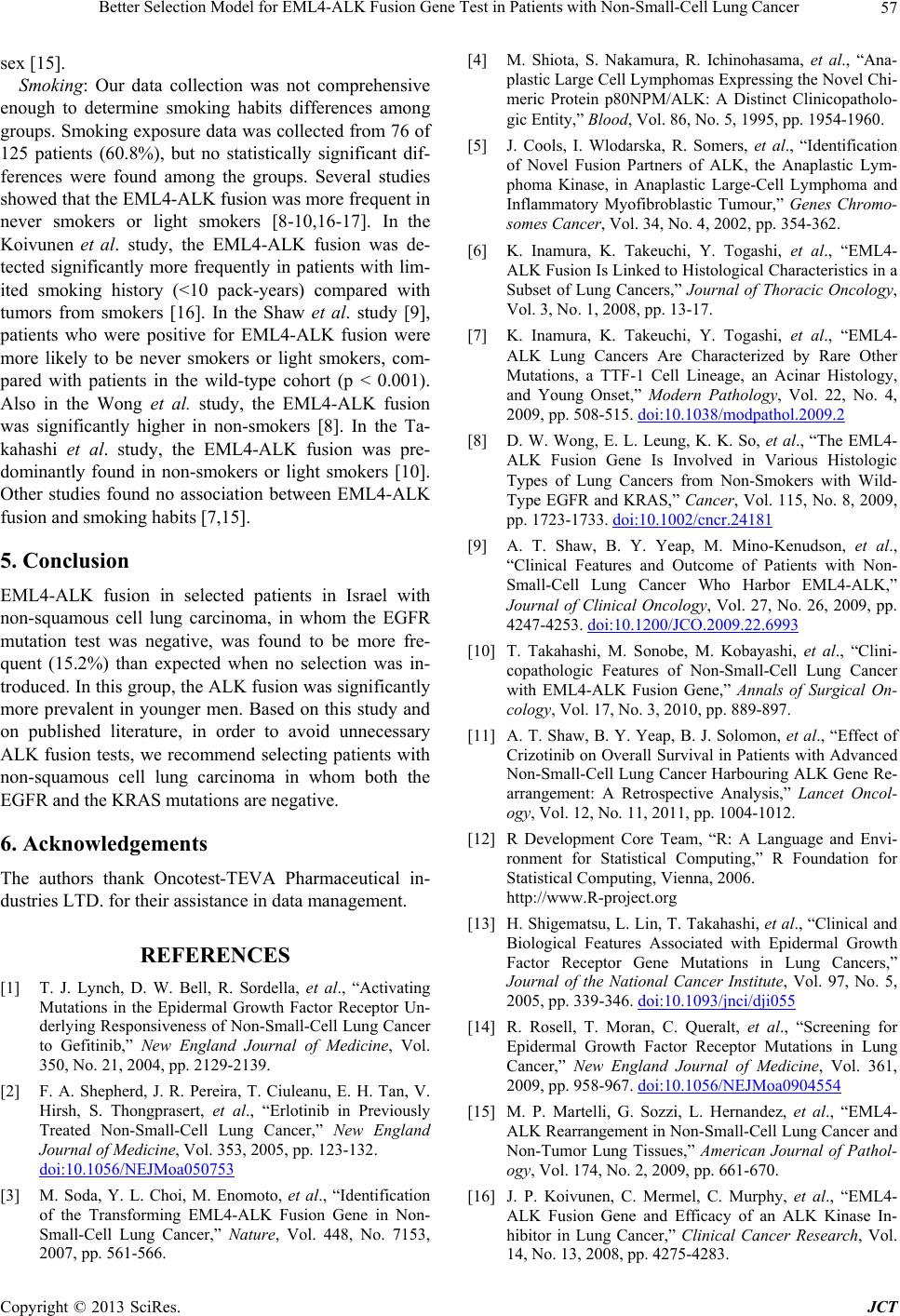
Better Selection Model for EML4-ALK Fusion Gene Test in Patients with Non-Small-Cell Lung Cancer 57
sex [15].
Smoking: Our data collection was not comprehensive
enough to determine smoking habits differences among
groups. Smoking exposure data was collected from 76 of
125 patients (60.8%), but no statistically significant dif-
ferences were found among the groups. Several studies
showed that the EML4-ALK fusion was more frequent in
never smokers or light smokers [8-10,16-17]. In the
Koivunen et al. study, the EML4-ALK fusion was de-
tected significantly more frequently in patients with lim-
ited smoking history (<10 pack-years) compared with
tumors from smokers [16]. In the Shaw et al. study [9],
patients who were positive for EML4-ALK fusion were
more likely to be never smokers or light smokers, com-
pared with patients in the wild-type cohort (p < 0.001).
Also in the Wong et al. study, the EML4-ALK fusion
was significantly higher in non-smokers [8]. In the Ta-
kahashi et al. study, the EML4-ALK fusion was pre-
dominantly found in non-smokers or light smokers [10].
Other studies found no association between EML4-ALK
fusion and smoking hab i ts [7,15] .
5. Conclusion
EML4-ALK fusion in selected patients in Israel with
non-squamous cell lung carcinoma, in whom the EGFR
mutation test was negative, was found to be more fre-
quent (15.2%) than expected when no selection was in-
troduced. In this group, the ALK fusion was significantly
more prevalent in younger men. Based on this study and
on published literature, in order to avoid unnecessary
ALK fusion tests, we recommend selecting patients with
non-squamous cell lung carcinoma in whom both the
EGFR and the KRAS mutations are negative.
6. Acknowledgements
The authors thank Oncotest-TEVA Pharmaceutical in-
dustries LTD. for their assistance in data management.
REFERENCES
[1] T. J. Lynch, D. W. Bell, R. Sordella, et al., “Activating
Mutations in the Epidermal Growth Factor Receptor Un-
derlying Responsiveness of Non-Small-Cell Lung Cancer
to Gefitinib,” New England Journal of Medicine, Vol.
350, No. 21, 2004, pp. 2129-2139.
[2] F. A. Shepherd, J. R. Pereira, T. Ciuleanu, E. H. Tan, V.
Hirsh, S. Thongprasert, et al., “Erlotinib in Previously
Treated Non-Small-Cell Lung Cancer,” New England
Journal of Medicine, Vol. 353, 2005, pp. 123-132.
doi:10.1056/NEJMoa050753
[3] M. Soda, Y. L. Choi, M. Enomoto, et al., “Identification
of the Transforming EML4-ALK Fusion Gene in Non-
Small-Cell Lung Cancer,” Nature, Vol. 448, No. 7153,
2007, pp. 561-566.
[4] M. Shiota, S. Nakamura, R. Ichinohasama, et al., “Ana-
plastic Large Cell Lymphomas Expressing the Novel Chi-
meric Protein p80NPM/ALK: A Distinct Clinicopatholo-
gic Entity,” Blood, Vol. 86, No. 5, 1995, pp. 1954-1960.
[5] J. Cools, I. Wlodarska, R. Somers, et al., “Identification
of Novel Fusion Partners of ALK, the Anaplastic Lym-
phoma Kinase, in Anaplastic Large-Cell Lymphoma and
Inflammatory Myofibroblastic Tumour,” Genes Chromo-
somes Cancer, Vol. 34, No. 4, 2002, pp. 354-362.
[6] K. Inamura, K. Takeuchi, Y. Togashi, et al., “EML4-
ALK Fusion Is Linked to Histological Characteristics in a
Subset of Lung Cancers,” Journal of Thoracic Oncology,
Vol. 3, No. 1, 2008, pp. 13-17.
[7] K. Inamura, K. Takeuchi, Y. Togashi, et al., “EML4-
ALK Lung Cancers Are Characterized by Rare Other
Mutations, a TTF-1 Cell Lineage, an Acinar Histology,
and Young Onset,” Modern Pathology, Vol. 22, No. 4,
2009, pp. 508-515. doi:10.1038/modpathol.2009.2
[8] D. W. Wong, E. L. Leung, K. K. So, et al., “The EML4-
ALK Fusion Gene Is Involved in Various Histologic
Types of Lung Cancers from Non-Smokers with Wild-
Type E GFR and KRAS,” Cancer, Vol. 115, No. 8, 2009,
pp. 1723-1733. doi:10.1002/cncr.24181
[9] A. T. Shaw, B. Y. Yeap, M. Mino-Kenudson, et al.,
“Clinical Features and Outcome of Patients with Non-
Small-Cell Lung Cancer Who Harbor EML4-ALK,”
Journal of Clinical Oncology, Vol. 27, No. 26, 2009, pp.
4247-4253. doi:10.1200/JCO.2009.22.6993
[10] T. Takahashi, M. Sonobe, M. Kobayashi, et al., “Clini-
copathologic Features of Non-Small-Cell Lung Cancer
with EML4-ALK Fusion Gene,” Annals of Surgical On-
cology, Vol. 17, No. 3, 2010, pp. 889-897.
[11] A. T. Shaw, B. Y. Yeap, B. J. Solomon, et al., “Effect of
Crizotinib on Overall Survival in Patients with Advanced
Non-Small-Cell Lung Cancer Harbouring ALK Gene Re-
arrangement: A Retrospective Analysis,” Lancet Oncol-
ogy, Vol. 12, No. 11, 2011, pp. 1004-1012.
[12] R Development Core Team, “R: A Language and Envi-
ronment for Statistical Computing,” R Foundation for
Statistical Computing, Vienna, 2006.
http://www.R-project.org
[13] H. Shigematsu, L. Lin, T. Takahashi, et al., “Clinical and
Biological Features Associated with Epidermal Growth
Factor Receptor Gene Mutations in Lung Cancers,”
Journal of the National Cancer Institute, Vol. 97, No. 5,
2005, pp. 339-346. doi:10.1093/jnci/dji055
[14] R. Rosell, T. Moran, C. Queralt, et al., “Screening for
Epidermal Growth Factor Receptor Mutations in Lung
Cancer,” New England Journal of Medicine, Vol. 361,
2009, pp. 958-967. doi:10.1056/NEJMoa0904554
[15] M. P. Martelli, G. Sozzi, L. Hernandez, et al., “EML4-
ALK Rearrangement in Non-Small-Cell Lung Cancer and
Non-Tumor Lung Tissues,” American Journal of Pathol-
ogy, Vol. 174, No. 2, 2009, pp. 661-670.
[16] J. P. Koivunen, C. Mermel, C. Murphy, et al., “EML4-
ALK Fusion Gene and Efficacy of an ALK Kinase In-
hibitor in Lung Cancer,” Clinical Cancer Research, Vol.
14, No. 13, 2008, pp. 4275-4283.
Copyright © 2013 SciRes. JCT